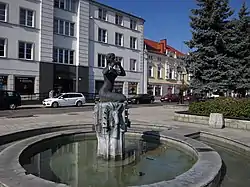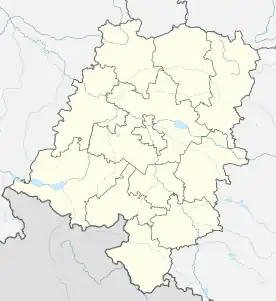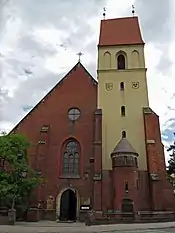Koźle
Koźle (German: Cosel) is a district of Kędzierzyn-Koźle (since 1975), Poland and is at the junction of the Kłodnica and Oder rivers, c. 50 km southeast of Opole. The district has a Roman Catholic church, a medieval chateau, remains of a 19th-century fortress and a high school. Koźle's industries include a shipyard and an inland port.
Koźle | |
|---|---|
 Rynek (Market Square) in Koźle | |
 Coat of arms | |
 Koźle  Koźle | |
| Coordinates: 50°20′7″N 18°8′45″E | |
| Country | |
| Voivodeship | Opole |
| County | Kędzierzyn-Koźle |
| Urban Gmina | Kędzierzyn-Koźle |
| First mentioned | 12th century |
| Town rights | 1281 |
| Merged into Kędzierzyn-Koźle | 1975 |
| Time zone | UTC+1 (CET) |
| • Summer (DST) | UTC+2 (CEST) |
| Vehicle registration | OK |
History

The settlement was first mentioned in the early 12th-century Gesta principum Polonorum, the oldest Polish chronicle. Its name comes from the Polish word kozioł, which means "goat". As a result of the fragmentation of Poland, from 1281 to 1355 Koźle was the seat of a splinter eponymous duchy ruled by a local branch of the Piast dynasty. Also in 1281, Koźle obtained town rights. After 1355, it remained under the rule of other branches of the Polish Piast dynasty until 1532, when it was absorbed to Bohemia. It was besieged several times during the Thirty Years War, and in 1645, it returned to Polish rule under the House of Vasa.
It fell to Prussia by the 1742 Treaty of Breslau. Frederick II converted it into a fortress which held against Austrian sieges in 1758, 1759, 1760 and 1762.[1] In 1807 it almost withstood a siege by the Von Deroy brigade of the Bavarian Army, which was allied with Napoleonic France. From 1871 it was part of the German Empire. Polish insurgents captured the part of the town east of the Oder during the 1921 Third Silesian Uprising, however, the town remained part of Germany in the interbellum. Local Polish activists were intensively persecuted by the Germans since 1937.[2] During World War II, the Germans operated three forced labour subcamps (E2, E153, E155) of the Stalag VIII-B/344 prisoner-of-war camp in the town.[3] In the final stages of the war, in 1945, a German-conducted death march of thousands of prisoners of several subcamps of the Auschwitz concentration camp passed through the town towards the Gross-Rosen concentration camp.[4] With the bulk of Silesia, it was among territories regained by Poland after World War II. However, 6,000 bomb craters were recorded in the Koźle Basin ranging from 16 feet (4.9 m) to 49 feet (15 m) in diameter, as American and British bombers dropped a total of 39,137 bombs in the region starting from February 1943, which was used by the German government for industrial fuel production.[5]
Notable residents
- Theodor von Scheve (1851–1922), chess master
- Georg Kaul (1873–1933), politician
- Erna von Dobschütz (1876–1963), painter
- Georg Rasel (1882–1945), German artist
- Kurt Liese (1882–1945), German general
- Moritz Hadda (1887–1942), Jewish-German architect
- Heinrich Tischler (1892–1938), German painter
- Irene Eisinger (1903–1994), singer
- Georg Wahl (1920–2013), equestrian
- Hanno von Graevenitz (1937–2007), German diplomat
- Ullrich Libor (1940–), German sportsman
- Mathias Fischer (1971–), sportsman
References
- Chisholm, Hugh, ed. (1911). . Encyclopædia Britannica. Vol. 7 (11th ed.). Cambridge University Press. p. 213.
- Cygański, Mirosław (1984). "Hitlerowskie prześladowania przywódców i aktywu Związków Polaków w Niemczech w latach 1939-1945". Przegląd Zachodni (in Polish) (4): 24.
- "Working Parties". Lamsdorf.com. Archived from the original on 29 October 2020. Retrieved 22 May 2021.
- "The Death Marches". Sub Camps of Auschwitz. Retrieved 27 June 2021.
- "6,000 WWII-era bomb craters mapped in Poland". Live Science. 17 March 2021.
![]() Media related to Kędzierzyn-Koźle at Wikimedia Commons
Media related to Kędzierzyn-Koźle at Wikimedia Commons